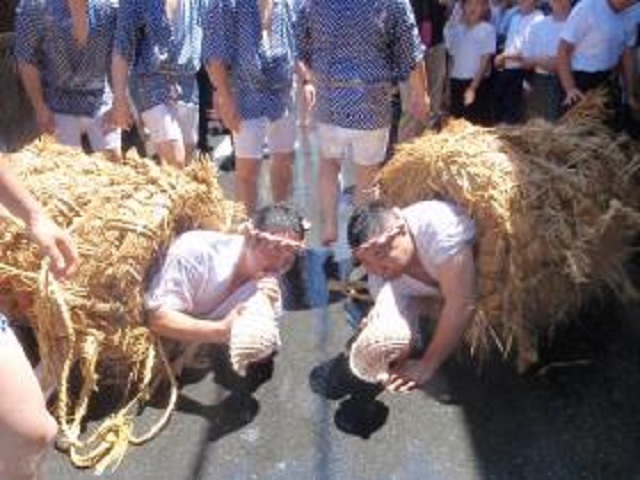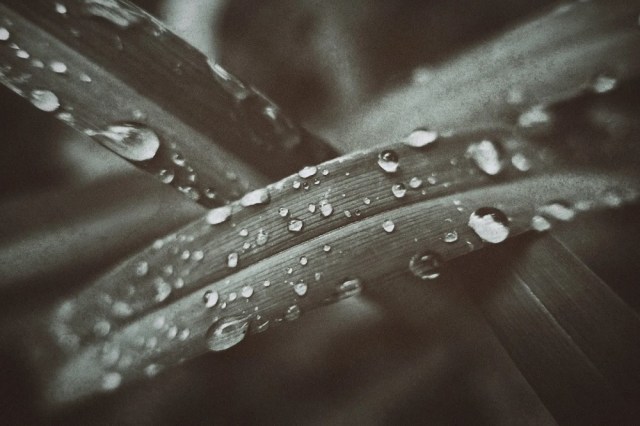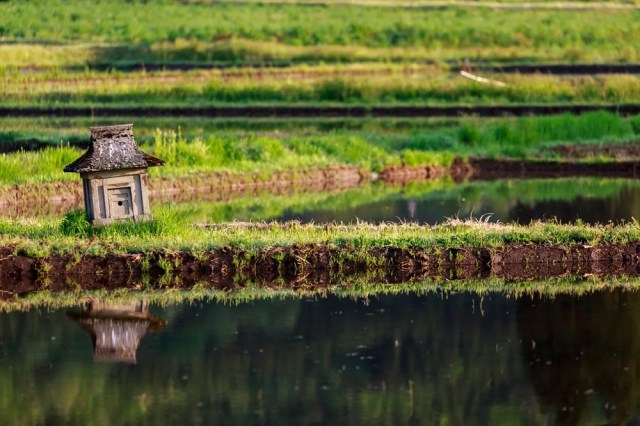
The story of a drought, dragons, and one of Japan’s craziest festivals.
Once upon a time, there was a village in Japan that desperately needed rain. One thing led to another, and now every year in Tokyo this happens:
大森の水止舞という奇祭をみてきました
— 東京刺激クラブ (@onda3simai4) July 14, 2019
ワラに包まれた人がホラ貝を吹いと引きづられ水をぶっかけられるというエライ目に遭うお祭りですがメタメタ面白かったです☆#東京刺激クラブ #水止舞 #大森 #奇祭 pic.twitter.com/WZ2I4U6HM6
Japan’s summer festivals often have their roots in traditional religious beliefs about the connection between gods, spirits, and forces of nature, and the Mizudome no Mai, which takes place at Gonshoji Temple in the Omori neighborhood of Tokyo’s Ota Ward, is no exception,
Many years ago, or perhaps we should say many, many years ago, since this happened all the way back in 1321, the people of Musashi no Kuni (as east Japan was called in those days) were suffering through a terrible drought. With the earth parched and crops withering, the people turned to the abbot of Gonshoji, asking him to beseech divine forces to bless them with rain.
Hearing the people’s pleas, the abbot constructed a statue of a dragon out of straw, since the creatures have long been associated with water and rainfall in Japanese folklore. The abbot then offered prayers, and before long they were answered, with rainclouds forming and shedding the long-awaited precipitation that ended the drought.
Things seem to have been more or less OK the next year, but the year after that the surrounding community found itself facing the opposite problem. Now there was too much rain, flooding the fields and ruining the efforts of the farmers as much as the drought had. Remembering that, to their knowledge, it was the abbot’s prayers that had brought rain two years prior, some villagers began to resent the priest, speculating that his prayers had been too effective and that they were now suffering the continuing consequences.
So once again, the abbot began crafting animal artwork. He made three lion masks, since the Japanese word for lion is “shishi,” but if written with different kanji characters and read in a somewhat obscure manner, shishi can also mean “stop the rain.”
This time the abbot distributed the masks to the villagers, instructing them to dance, and for others to bang taiko drums or blow into conch shells. This, the abbot said, would pacify the dragon who was causing the ceaseless storms, and once again, his proclamation proved true, as the weather returned to more moderate conditions and the floodwaters receded.
To commemorate this series of events, annually Gonshoji holds the Mizudome no Mai, or “Water-stopping Dance,” and the most dynamic part of the celebration is when two dudes, both usually quite large, are stuffed into cocoon-like straw sacks and carried through the streets of Omori, all while blowing on conch shells and being pelted with water.
【奇祭】男を藁でぐるぐる巻きにして、街中をゴロゴロ転がし、容赦なく水をぶっかける『水止舞』が、東京都大田区大森で7月10日(日)13時~15時開催。ぶっかけられた男はそのたびに法螺貝を吹く。https://t.co/XUHp2lKG1m pic.twitter.com/sUt8Kts1xS
— ほいじんが (@garaguda) June 29, 2022
Those two prone gentlemen represent the storm-bringing dragons, and the townspeople need to transport them to Gonshoji. The dragons, being somewhat rebellious types, won’t make the journey under their own power, and so groups of participants take turns carrying them, periodically dousing them in the creatures’ favorite element, and the blowing of the conch shells is meant to replicate their cries of draconic joy.
https://twitter.com/roko_zan/status/1018012679372341248 https://twitter.com/osamyoung/status/1542111227035258880The Mizudome no Mai takes place in July, and coinciding with the hottest time of the year in Japan means bystanders are only too happy to be hit by stray splashes of water that were aimed at the dragons. Because of the dragons’ weight, frequent stops have to be made, but the procession/carrying has musical accompaniment from flutes and drums, and once the dragons finally do reach the temple, a team of dancers performs while wearing headgear symbolizing the three lion masks made by the abbot for the townspeople during the floods.
▼ You might notice many of the participants wear clothes with a triangular pattern, which is meant to be evocative of a dragon’s scales.
https://twitter.com/tabigarasu24/status/1510830266306424834
Sadly, the Mizudome no Mai could not be held in 2020 or 2021 due to coronavirus precaution protocols. For 2022, though, the procession will be retuning, with this year’s iteration starting at 1 p.m. on Sunday, July 10.
Temple information
Gonshoji / 厳正寺
Address: Tokyo-to, Ota-ku, Omori Higashi Sanchome 7-27
東京都大田区大森東三丁目7番27号
Source: Mizudome no Mai official website via Hamster Sokuho, Ota Ward
Top image: Ota Ward
Insert images: Pakutaso (1, 2)
● Want to hear about SoraNews24’s latest articles as soon as they’re published? Follow us on Facebook and Twitter!



 Japan’s kanji character of the year for 2017 is “north”
Japan’s kanji character of the year for 2017 is “north” Japan announces Kanji of the Year for 2019, and it was really the only logical choice
Japan announces Kanji of the Year for 2019, and it was really the only logical choice Japan’s Kanji of the Year revealed, reflects both the good and the bad of 2022
Japan’s Kanji of the Year revealed, reflects both the good and the bad of 2022 Mermaid mummy stored at Japanese temple has true identity revealed after year-long study【Video】
Mermaid mummy stored at Japanese temple has true identity revealed after year-long study【Video】 A Japanese tea house for inside your house? Tokyo company wants to offer micro chashitsu overseas
A Japanese tea house for inside your house? Tokyo company wants to offer micro chashitsu overseas Tokyo Tsukiji fish market site to be redeveloped with 50,000-seat stadium, hotel, shopping center
Tokyo Tsukiji fish market site to be redeveloped with 50,000-seat stadium, hotel, shopping center Japanese ramen restaurants under pressure from new yen banknotes
Japanese ramen restaurants under pressure from new yen banknotes McDonald’s new Happy Meals offer up cute and practical Sanrio lifestyle goods
McDonald’s new Happy Meals offer up cute and practical Sanrio lifestyle goods French Fries Bread in Tokyo’s Shibuya becomes a hit on social media
French Fries Bread in Tokyo’s Shibuya becomes a hit on social media Pokémon Sleep camping suite and guestrooms coming to Tokyo Hyatt along with giant Snorlax burgers
Pokémon Sleep camping suite and guestrooms coming to Tokyo Hyatt along with giant Snorlax burgers New private rooms on Tokaido Shinkansen change the way we travel from Tokyo to Kyoto
New private rooms on Tokaido Shinkansen change the way we travel from Tokyo to Kyoto We tried Korea’s way-too-big King Tonkatsu Burger at Lotteria 【Taste Test】
We tried Korea’s way-too-big King Tonkatsu Burger at Lotteria 【Taste Test】 Cosplay in front of explosions and flames at the upcoming fiery Baku Festival
Cosplay in front of explosions and flames at the upcoming fiery Baku Festival Beautiful Ghibli sealing wax kits let you create accessories and elegant letter decorations【Pics】
Beautiful Ghibli sealing wax kits let you create accessories and elegant letter decorations【Pics】 Secret Kitchen bento serves Japanese flowers, birds, wind and moon in a box, but is it worth it?
Secret Kitchen bento serves Japanese flowers, birds, wind and moon in a box, but is it worth it? All-you-can-drink Starbucks and amazing views part of Tokyo’s new 170 meter-high sky lounge
All-you-can-drink Starbucks and amazing views part of Tokyo’s new 170 meter-high sky lounge More foreign tourists than ever before in history visited Japan last month
More foreign tourists than ever before in history visited Japan last month Starbucks reopens at Shibuya Scramble Crossing with new look and design concept
Starbucks reopens at Shibuya Scramble Crossing with new look and design concept Studio Ghibli releases new action figures featuring Nausicaä of the Valley of the Wind characters
Studio Ghibli releases new action figures featuring Nausicaä of the Valley of the Wind characters Studio Ghibli glasses cases let anime characters keep an eye on your spectacles
Studio Ghibli glasses cases let anime characters keep an eye on your spectacles Is the new Shinkansen Train Desk ticket worth it?
Is the new Shinkansen Train Desk ticket worth it? Studio Ghibli releases Kiki’s Delivery Service chocolate cake pouches in Japan
Studio Ghibli releases Kiki’s Delivery Service chocolate cake pouches in Japan New definition of “Japanese whiskey” goes into effect to prevent fakes from fooling overseas buyers
New definition of “Japanese whiskey” goes into effect to prevent fakes from fooling overseas buyers Our Japanese reporter visits Costco in the U.S., finds super American and very Japanese things
Our Japanese reporter visits Costco in the U.S., finds super American and very Japanese things Studio Ghibli unveils Mother’s Day gift set that captures the love in My Neighbour Totoro
Studio Ghibli unveils Mother’s Day gift set that captures the love in My Neighbour Totoro Domino’s Japan now sells…pizza ears?
Domino’s Japan now sells…pizza ears? New Japanese KitKat flavour stars Sanrio characters, including Hello Kitty
New Japanese KitKat flavour stars Sanrio characters, including Hello Kitty New Pokémon cakes let you eat your way through Pikachu and all the Eevee evolutions
New Pokémon cakes let you eat your way through Pikachu and all the Eevee evolutions Sales of Japan’s most convenient train ticket/shopping payment cards suspended indefinitely
Sales of Japan’s most convenient train ticket/shopping payment cards suspended indefinitely Sold-out Studio Ghibli desktop humidifiers are back so Totoro can help you through the dry season
Sold-out Studio Ghibli desktop humidifiers are back so Totoro can help you through the dry season Japanese government to make first change to romanization spelling rules since the 1950s
Japanese government to make first change to romanization spelling rules since the 1950s Ghibli founders Toshio Suzuki and Hayao Miyazaki contribute to Japanese whisky Totoro label design
Ghibli founders Toshio Suzuki and Hayao Miyazaki contribute to Japanese whisky Totoro label design Doraemon found buried at sea as scene from 1993 anime becomes real life【Photos】
Doraemon found buried at sea as scene from 1993 anime becomes real life【Photos】 Tokyo’s most famous Starbucks is closed
Tokyo’s most famous Starbucks is closed One Piece characters’ nationalities revealed, but fans have mixed opinions
One Piece characters’ nationalities revealed, but fans have mixed opinions We asked a Uniqlo employee what four things we should buy and their suggestions didn’t disappoint
We asked a Uniqlo employee what four things we should buy and their suggestions didn’t disappoint Princesses, fruits, and blacksmiths: Study reveals the 30 most unusual family names in Japan
Princesses, fruits, and blacksmiths: Study reveals the 30 most unusual family names in Japan Shocking cat graffiti at centuries-old Japanese temple is shockingly uncute【Video】
Shocking cat graffiti at centuries-old Japanese temple is shockingly uncute【Video】 New Samurai Stormtrooper from Tamashii Nations is ready to fire up the troops for feudal battle
New Samurai Stormtrooper from Tamashii Nations is ready to fire up the troops for feudal battle Cosplay organization receives official government grant from Tokyo’s Ota Ward
Cosplay organization receives official government grant from Tokyo’s Ota Ward Temple camping in Japan at Wakayama’s Daitaiji【Photos】
Temple camping in Japan at Wakayama’s Daitaiji【Photos】 The Star Wars folding screens just unveiled at Kyoto’s Kiyomizu Temple are amazing
The Star Wars folding screens just unveiled at Kyoto’s Kiyomizu Temple are amazing LoCoS: The universal language we’ll be using by 2065, according to legendary Japanese designer
LoCoS: The universal language we’ll be using by 2065, according to legendary Japanese designer Fukuoka town builds enormous Godzilla replica out of… straw?
Fukuoka town builds enormous Godzilla replica out of… straw? Akutai Matsuri: Japan’s Verbal Abuse Festival, where insults and bad behaviour are encouraged
Akutai Matsuri: Japan’s Verbal Abuse Festival, where insults and bad behaviour are encouraged Flush your prayers down the toilet at this unique Japanese temple
Flush your prayers down the toilet at this unique Japanese temple Yu-Gi-Oh! brings anime battles into real-life with amazing fan-made dueling arena【Video】
Yu-Gi-Oh! brings anime battles into real-life with amazing fan-made dueling arena【Video】 Georgian Paralympic judo athlete arrested for attacking a security guard in a Tokyo hotel
Georgian Paralympic judo athlete arrested for attacking a security guard in a Tokyo hotel Living tree bridges and other breathtaking scenery at the rainiest place on Earth
Living tree bridges and other breathtaking scenery at the rainiest place on Earth Pretty pink coffins to sleep in now on sale in Japan, made by local Tokyo craftsmen【Photos】
Pretty pink coffins to sleep in now on sale in Japan, made by local Tokyo craftsmen【Photos】 Costume-less Chinese lion dance videos show real humans, real behind-the-scenes magic【Video】
Costume-less Chinese lion dance videos show real humans, real behind-the-scenes magic【Video】 Japan’s number one cosplayer Enako wows crowds at Halloween event in Tokyo
Japan’s number one cosplayer Enako wows crowds at Halloween event in Tokyo Voice of Metal Gear Solid’s Solid Snake/Big Boss completes Tokyo coronavirus vaccination mission
Voice of Metal Gear Solid’s Solid Snake/Big Boss completes Tokyo coronavirus vaccination mission
Leave a Reply